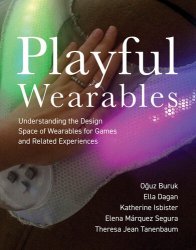Playful Wearables: Understanding the Design Space of Wearables for Games and Related Experiences
- Добавил: literator
- Дата: 5-01-2024, 11:12
- Комментариев: 0
 Название: Playful Wearables: Understanding the Design Space of Wearables for Games and Related Experiences
Название: Playful Wearables: Understanding the Design Space of Wearables for Games and Related ExperiencesАвтор: Oğuz Buruk, Ella Dagan, Katherine Isbister
Издательство: The MIT Press
Год: 2024
Страниц: 241
Язык: английский
Формат: pdf, epub (true), mobi
Размер: 10.1 MB
An expert introduction to the world of “playful wearables” and their design, with a wide range of engaging examples, case studies, and exercises.
This pioneering introduction to the world of wearable technology takes readers beyond the practical realm (think Fitbits, Apple Watches, and smartglasses) to consider another important side of the technology—the playful. Playful Wearables offers an engaging account of what “playful wearables” are, why they matter, how they work, how they’re made, and what their future might hold. The book’s authors draw on decades of experience in design, development, and research to offer real-world examples, exercises, and implications, showing how this kind of wearable tech can introduce an invaluable element of play into our everyday lives.
As wearable technology emerges in the ecology of costume and fashion, the authors consider its intimate connection to identity and culture. And they look at the ways in which playful wearables, when smoothly integrated into everyday social experiences, support social interaction. The book then moves on to the mechanics of playful wearables—from design strategies and frameworks to specific methods and game design patterns. All of these elements point to possibilities beyond the realm of games and dedicated play, as the value and uses of playful wearables in the larger world of self, society, and culture become ever more apparent.
Wearable technology has become increasingly commonplace in our everyday lives. You, our reader, may be wearing one of these devices right now, whether it’s a fitness tracker such as the Fitbit, a smartwatch such as the Apple Watch, or perhaps smartglasses such as Snap’s Spectacles. Most people use these devices to track wellness and fitness data about themselves or to connect to others through social media, text messages, calendar alerts, and the like. This frames wearables as serious business, keeping us in touch with our own health and helping us maintain social ties. In this book, you’ll learn about and explore design considerations for another side of wearables: their potential to support play.
Play is a vital aspect of human well-being, not just for children, but also for adults. It makes us happy, and it helps support our connections to one another. It’s often a reason to be active, as well—sports and playground games get us up and moving. Play and games also help us to break away from only designing for functional, goal-driven purposes, and lead to designs that include underexplored but very valuable moment-to-moment experiential qualities. Wearable technology offers some really interesting possibilities for enhancing games and playful interaction, which the authors believe will grow in the coming years, and will also influence design directions for “serious” wearables. In this book, we share our cutting-edge knowledge and expertise about playful wearables to help you, the reader, understand the great potential of wearables to support play. If you are a product designer, developer, student, or researcher, this book will prepare you to create exciting new playful wearable experiences and products.
Wearable: When we use this term, we mean any device that is worn on the body and that supports interaction with computation. The wearable device usually has some computing power built into it, but it may also rely on the computing power of another device. For example, a smartwatch has computation within it, but it often also relies on communication with a smartphone in order to do all the things that it is designed to do. Examples of wearables include fitness tracker bracelets, smartwatches, smartglasses, smart pendants, smart clothing and haute couture, and other worn technologies. One could consider virtual reality (VR) headsets as another example of a wearable technology, though VR is a special case of its own that we don’t cover thoroughly in this text.
Human-computer interaction (HCI): This commonly used phrase describes an area of research, design, and development that is focused on understanding and designing the ways that people interact with technologies. HCI researchers and designers are the people who think through and plan how you will interact with products that include computation, ranging from voice input (talking to products like Alexa or Siri), to using a touch-based device like a smartphone, to working with a keyboard and touchpad on a laptop, to giving gesture-based commands with a smartwatch. HCI researchers and developers have played a central part in shaping wearable technologies, and the authors of this book are all active in the HCI design and research community.
To illustrate the complex interplay between form, function, meaning, and identity that wearable designers must navigate, we provide two examples of commercial wearable smartglasses. The first—Google Glass—is quite well known. The second—Oakley’s Thump—was more of a novelty item that many people have likely forgotten. Each of these occupied a different aesthetic niche and aspired to a different technological function, and each of them met with only mixed success in the consumer wearables market.
Скачать Playful Wearables: Understanding the Design Space of Wearables for Games and Related Experiences
[related-news] [/related-news]
Внимание
Уважаемый посетитель, Вы зашли на сайт как незарегистрированный пользователь.
Мы рекомендуем Вам зарегистрироваться либо войти на сайт под своим именем.
Уважаемый посетитель, Вы зашли на сайт как незарегистрированный пользователь.
Мы рекомендуем Вам зарегистрироваться либо войти на сайт под своим именем.
